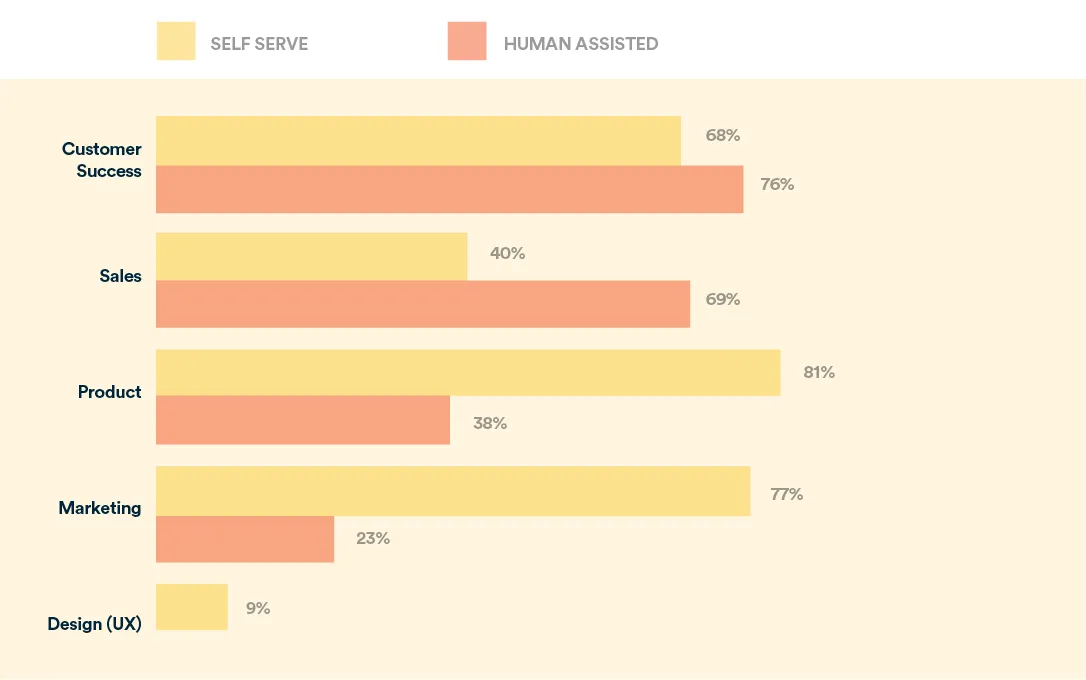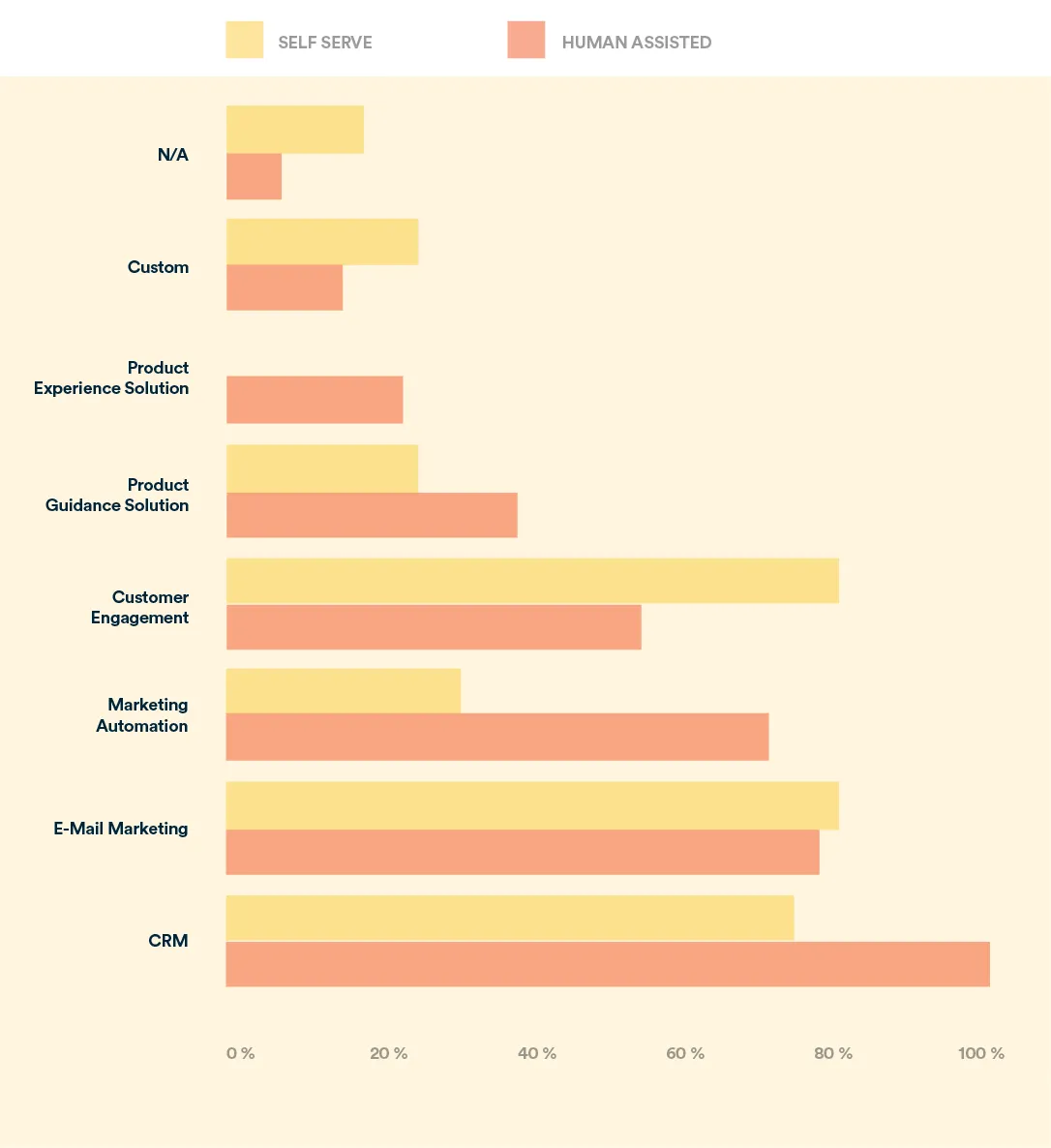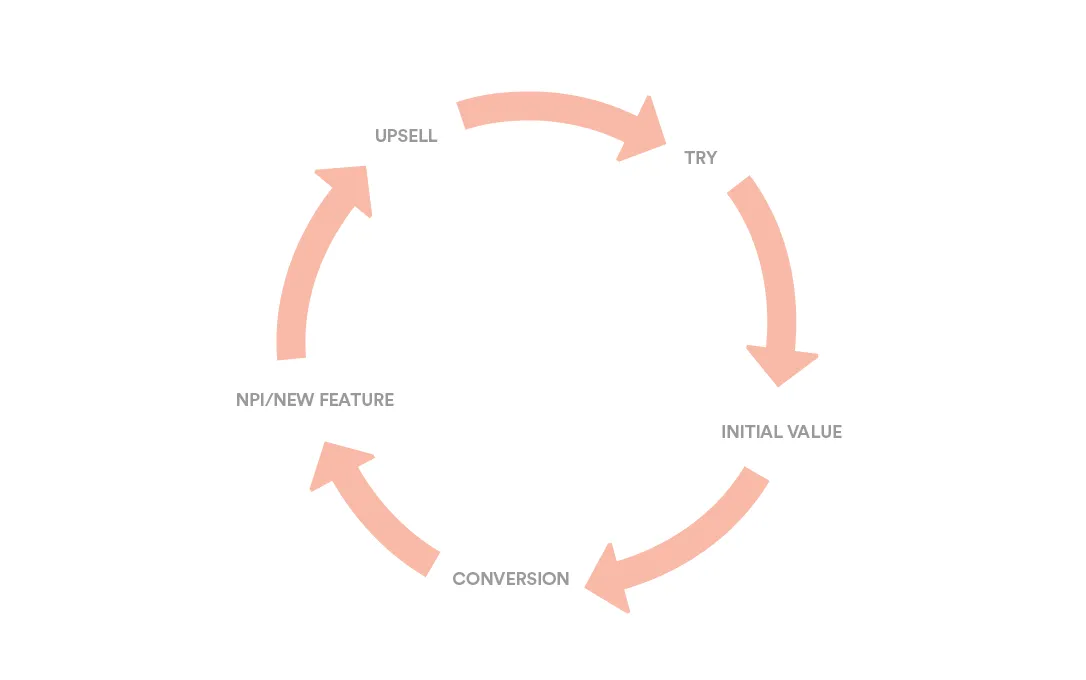Product-Led Growth in SaaS: Identifying the Opportunities

The following article takes a first-hand look into the findings of The State of Product-Led Experience, a comprehensive SaaS report conducted by the Product-Led Growth expert, Despina Exadaktylou. In this extensive report consisting of data from 40 top SaaS organizations, Despina was able to uncover the competing strengths of successful product-led businesses and their ability to enhance the product experience throughout the customer journey. Find out what is needed to overcome the current market challenges and solutions which accompany the transition to becoming a truly product-led SaaS business.
Table of Contents
Introduction
This mini-guide is derived from “The State of Product Led Experience”, a research project on emerging SaaS Go-To-Market practices within a product-led strategy. Its aim is to present current strategies as well as plausible future tactics that can be adopted when making the transition to a product-led GTM model. All recommendations and analysis were based on extensive research of 40 SaaS organizations. The participants in this research included small/medium, mid-market, and enterprise businesses using a self-serve or human-assisted onboarding strategy.
The research has distilled findings from a detailed analysis of 50 interviews and surveys covering the most important best practices for product management, marketing, and sales.
By including both qualitative and quantitative data, the survey portrays a more detailed analysis of the customer journey, from activation through retention, reactivation, and customer loyalty.
The Product (Led) Imperative
We have been hearing for a while how product-led GTM practices can revolutionize the way SaaS businesses function. This model may seem like it’s already dominant, but the truth is that the SaaS industry is not completely there yet.
Inconsistencies in GTM practices, limited experimentation, and infinite hand-holding still prevail across the industry. This resonates partially since transitioning from one practice to another is not something that is achieved overnight. On the other hand, denying the importance of optimized product experience makes it even harder for these organizations to achieve sustainable growth and long-term prosperity.
But what exactly does a product-led GTM model entail? Essentially, a product-led strategy puts the product in the center and holds it accountable for acquiring, retaining, and growing new and existing accounts. Unlike a marketing-led GTM model, where online behavior KPIs are at the forefront, a product-led model needs in-product behavior, customer feedback, in conjunction with product analytics to streamline the customer journey.
Stellar Customer Experience
While the adoption and delivery of product-led practices may sound like the one-way street, this transition entails many challenges.
In the customer experience era, where customers expect to grow within a service without facing any inconsistencies, products’ delivery through an array of channels and devices is only making the shift more challenging, especially when internal teams follow different agendas which eventually compromise customer experience.
The first step to eliminating this effect is to align all parties in perfect harmony with each other and abandon internal silos. Additionally, shifting growth from acquisition to retention needs to be considered by many businesses, which, until very recently, were focused on acquiring customers without necessarily adopting a mechanism to sustain them.
If we add on how consumerization increases customer expectations, fierce competition, the abandonment of long-term contracts, and the dominance of customers’ voice on social mediums, we have the rise of an era where stellar product experience becomes the holy grail leading to hypergrowth.
The Multivariate Role of User Onboarding
The emerging role of product management and the multiple releases following its practices radically affect product experience.
Onboarding, typically defined so far as the set of steps leading to initial value, is evolving to the single source of truth following users’ proficiency and growth. Product data capitalization enables onboarding assessment on every feature release and expands its prevalence far beyond the activation stage.
Organizations targeting high trajectory customers, usually ingrained into human-assisted procedures, are finally able to harmonize their high-tech high-touch activations. Product usage monitoring enables customer-facing teams to act proactively while simultaneously passing on the necessary feedback to product management.
At the same time, SMBs can deliver a scalable self-serve approach driven by product data and passive customer feedback that will not contain out-of-context messages but rather tailored experiences. This will support their mission to stand out from the competition.
In both instances, Product-Led onboarding becomes a more scalable framework that enables accounts to grow by considering users’ proficiency and context of usage.
Becoming Product-Led
The steps organizations need to take when making the transition to becoming product-led cannot be limited to a few words. This mini-guide pinpoints basic product-led methodologies internal teams can follow when striving to optimize product delivery.
In the following sections, we will focus on three areas where a product-led GTM strategy meets onboarding activations
These areas are:
- The dispersed role of any onboarding team
- How to harmonize high-touch and high-tech onboarding touchpoints
- Ways to assess product experience
Step 1: Create a Cross-Functional Onboarding Team
The abandonment of silos radically affects an onboarding team’s composition.
Being a composite of Customer Success and Sales in big organizations – or Product Management and Marketing in smaller ones – onboarding teams’ DNA should be dispersed across various departments at all times.
A major product-led challenge for any organization is having departments with different bases built into the concept of where the product is currently, as opposed to where it might be in the future.
As the product’s main gatekeeper, Product Management should be involved in onboarding delivery and establishing an ongoing feedback loop with customer-facing teams to make the delivery of a stellar product experience an intentional effort across the entire organization.
The research revealed that regarding human-assisted onboarding, the industry is still far from its goal. Customer Success (76%) and Sales (69%) have main ownership while Product Management (38%) and Marketing (23%) come last.

On the other side of the spectrum, organizations delivering a self-serve approach need to speed up the onboarding process by shortening time-to-value and increasing conversions.
While in this instance Product Management (81%) and Marketing (77%) may be highly involved, the research showed that Customer Success (68%) and Sales (40%) outreach is still in order.
Exemplary product-led organizations already disperse onboarding ownership across various teams.
In Hubspot’s case, for example, onboarding is such a broad concern and interest area that requires collaboration and spans across multiple departments, including Professional Services, Marketing, and Product Management.
The structure of Hubspot’s product team includes product groups or families within which there are many small and autonomous teams. This composite, by default, embraces ownership, quick iteration, and decision making.
In the case of the growth product group for example, there is a team focused on Acquisition, Onboarding, Retention, and Monetization. Each of these teams has a triad (PM, Designer, Tech Lead) and software engineers in order to function. At the same time, the family group is substituted by a user researcher, product analysts, and marketers who serve as shared resources. So in this context, the user researcher works with the acquisition, onboarding, retention, and monetization teams.
For the unicorn in inbound marketing, the challenge lies in finding the one shared metric, acting as a point of reference across teams. While one department may be measuring the number of support calls and churn rates, another would focus on retention rates and usage.
All these metrics complement each other, but the fact that they assess different parameters makes alignment an ongoing effort.
Key takeaway:
The industry’s transitioning stage resonates with the research data. When serving mid-market and enterprise customers, onboarding goes beyond educating on products’ functionalities. Customer-facing teams have to both manage the training needs of multiple departments and deal with customers’ business goals at the same time. By default, the involvement of customer-facing departments is increased throughout the customer lifecycle. This is a quality that seems to be following self-serve onboarding too.
The goal for both strategies is to reduce internal teams’ involvement regarding in-product onboarding activations and increase it whenever strategic decisions need to be taken. This can be achieved by acknowledging that each engagement can now be mapped and assessed while setting an evaluation system reflecting on the expected onboarding deliverables. This will give each team the ability to optimize onboarding flows by eliminating bottlenecks and insert product measurements in their evaluations at the same time.
Step 2: High-Touch High-Tech Harmonization
Education, which is a rather conflicting matter for every organization, is the low hanging fruit between successful adoption and inevitable churn. Being the main education carrier, onboarding needs to educate users seamlessly by being, quite literally, the extension of the product itself. The research proved that educational practices optimization is the end goal of any customer-facing team.
Companies serving SMBs inject these practices in the product both by design and by investing in scalable practices that double down on features capabilities. Ideally, customer-facing teams capitalize on the trends product data reveal and optimize onboarding by following users’ existing workflows. That being said, the increased involvement of Customer Success in onboarding delivery proves the opposite. This is a fact that leads us to the conclusion that retention costs are increased without necessarily being excused by customers’ LTV.
On the flip side, when serving Mid-Market and Enterprise customers, organizations have to reassure that those businesses’ entire employee bases will be efficient as digital natives, and this is achievable only via providing the right training. Big organizations struggle moving forward as they realize that their employees need to evolve radically.
Yet, there is no standard sufficient way to train thousands of people. It is thus critical for customer-facing teams to set the right expectations and personalize the educational practices to successfully meet customers’ needs. The educational framework designed and delivered has to be equally invested in how users can navigate effectively on its processes and instill confidence that they will achieve product excellence. In this instance, the increased involvement of customer-facing teams is a necessity.
Βesides the costs following human intervention, the research proved that another challenge following onboarding was the inability to monitor and evaluate the educational activations’ ROI. The adopted onboarding toolset can measure when help content is viewed, but it does not offer the possibility to evaluate whether adoption, activation, or even retention rates are embraced or discouraged.

Organizations need to analyze behavioral data in conjunction with engagement rates to accurately evaluate which onboarding activations affect users’ performance and to what degree.
Key Takeaway:
While a knowledge base, webinars, videos, academy creation, and marketing content as educational onboarding tactics are preferred by the majority of participants, organizations serving the Mid-Market and Enterprise seemed to favor a hybrid onboarding approach too. This approach successfully merges Customer Success activations with scalable product onboarding tactics (eg. targeted walkthroughs). The hybrid onboarding model’s benefits are, in short, decreased time-to-initial value, increased adoption rates (30%), and reduced costs and Customer Success activations (60%).
Step 3: Assess Product Experience
The optimization of scalable product engagement activations is the major conflict following onboarding delivery. On the one hand, by showing random messages to users and neglecting the learning curve period, their user role or proficiency levels have a negative effect on activation or adoption rates. On the other side of the spectrum, eliminating in-product onboarding time by investing in data-driven product engagements allows Sales and Customer Success to focus on customers’ business goals while reducing unnecessary costs.
The secret lies in presenting product onboarding engagements in front of users by focusing on their behavior. As long as Product Management is absent from onboarding delivery, Sales and Customer Success will act as product champions who may miss context on every touchpoint.
Product data, being product-led practices’ panacea, should dictate where any engagement should take place. This investment does not solely mean displacing product activations just for the sake of experimentation, per se. Any iteration should follow a specific logic since random displacements of users’ attention will increase friction while simultaneously keeping conversions and retention rates low.
(a) Current Onboarding Evaluations
The research proved that currently, organizations are focusing mainly on business KPIs (51%) and emerging product metrics (34%). Business metrics may be substantial in evaluating customers’ behavior in high level, but they cannot actually explain the reason behind the end results that surface.
According to the research, the main KPIs evaluating user behavior were:
User Behavioral Metrics Per Onboarding Strategy
- For both strategies (namely self-serve and human-assisted onboarding), Monthly Churn Rate (83%), NPS (65%), and Key Features Adoption (55%) prevail among other metrics.
- 40% of the user behavioral metrics uncovered were product related, 40% marketing, and 15% business.
- PQL measurements are used by 35% of participants across both strategies.
User Behavioral Metrics Per Department
- Marketing (46%) favors PQL scorings in their evaluations, followed by Customer Success (36%) and Product Management (33%).
- Key Feature Adoption is monitored by Customer Success (63%), followed by Product Management (51%) and Marketing (46%).
- Time to Invite Team Members (Breadth of Use) is mostly monitored by Customer Success (33%), while Product Management ranks second (17%) and Marketing (9%) last.
- The ROI onboarding yields (Conversions) is monitored mostly by Customer Success (55%) and Marketing (46%) while Product Management (21%) comes last.
(b) Onboarding Toolset
The second bottleneck, following user behavior evaluation, is the adopted onboarding toolset.
The main issue is that while these tools may offer product measurements on multiple dimensions on an account/user-level, they don’t provide usage and UI instrumentation evaluations. Consequently, organizations in favor of these solutions have a short-sighted view on users’ behavior.
At the same time, human-assisted adopters skyrocket CAC and retention costs by disposing of human resources constantly. At this point, it is important to note that a minority of them (20%) adopt solutions that are able to evaluate product experience end-to-end.
The advanced analytics programs put together quantitative and qualitative measurements to derive the right insights and data. The main product metrics used by these organizations are the breadth, depth, efficiency, and frequency of use along with customer feedback.
In high level, the main characteristics of these analytics are:
- User Mapping
These programs skew users’ progress on both a micro and macro level, irrespective of whether an account is moving forward retention and expansion.
- Customer Feedback Capitalization
By investing in solutions that release measurable product engagement actions, customer feedback is reinforced and complements Sales and/or Customer Success activations.
- Heavy experimentation
Experimentation is embraced since these programs deliver insights on users’ in-app behavior and enable internal teams to experiment with product engagement practices.
(c) Product Engagements Evaluations
Product managers should reinforce product engagement evaluations to measure the uptake and impact of new features and product launches. By investing in advanced analytics programs, internal teams reach the right conclusions regarding customers’ needs and products’ evolution. In the long term, this will lead to the creation of better products that live up to their value proposition.
So far, the term Product-Qualified lead (PQL) is used to assess users’ usage and adoption levels. On the downside, the PQL term is limited to the point where a paid conversion is made. In order to accurately evaluate prospects’ behavior, organizations should consider Product OQLs™ (Product Onboarding Qualified Leads) in their day-to-day assessments.
This term relies on existing metrics (like breadth and depth of use) which product-led organizations employ to assess product experience. Depending on the preferred onboarding strategy and stage of the customer journey, these metrics are being supplemented by additional business KPIs.
By being able to evaluate each feature release, internal teams are able to assess onboarding effectiveness and ROI at every stage of the customer journey. At every release, the onboarding process is reactivated to deliver initial value, lead to upgrades, and further account expansion.

Key Takeaway:
The fact that product KPIs are not fully adopted indicates that there is room for improvement when evaluating user behavior and products’ performance. That being said, product-led practices have already altered the way SaaS organizations measure customer satisfaction as they are starting to consider product engagements’ deliverables in their evaluations.
This is somewhat expected since:
- Product Management is now directly associated with organizations’ growth and needs.
- Organizations have started to employ advanced analytics programs.
- Product data capitalization enables organizations to assess every step a user makes in-app.
Product-led Recommendations
The research findings challenge internal teams to take a closer look at the GTM methodologies, processes, and toolset adopted. Ideally, the GTM strategy should focus on both the optimization of every touchpoint and the successful synchronization across departments.
Product-led practices evangelize both aspects and don’t focus on vanity metrics but rather on products’ value by investing in the outcomes of in-product behavior.
The recommendations mentioned in this mini-guide emphasize the aspects a product-led GTM approach should entail, such as:
- The investment in product data and the development of associated metrics. In a few years from now, data analysts will deliver multiple forecasts and growth scenarios, which will have, as a sole denominator, the historic data of the product itself.
- The product-led GTM practices velocity allow. internal teams to adopt a systemic process by putting the product at the epicenter. Usage levels can now dictate when customer-facing teams should act proactively to save the day or whenever the product should pave the way.
- Emerging technologies help to evaluate user behavior at each step on the customer journey in conjunction with customer feedback. This fact alone embraces the delivery of a customer-facing approach, which focuses on products’ superpowers.
While the SaaS industry has disrupted the digital economy by introducing a business model that every organization can, in time, adopt, it will, in the end, actually introduce something far greater: A way to deliver a significantly improved service through the ongoing monitoring of customer behavior.
While this conclusion can have many interpretations, take a minute to consider:
- The amount of resources organizations will be able to save when launching features that fit customers’ needs exactly.
- The customer satisfaction derived from product experiences that are seamless and intuitive.
- Increased levels of successful investment in products that fit organizations’ mission and vision.
- How much customer advocacy will increase and churn levels will decrease.
By adopting a product-led GTM strategy, organizations are able to evaluate, understand, and drive feature adoption while ensuring that customers get the most value from the products.
Feel free to use these guidelines as a supplement to your existing organizational handbook and make sure to involve every customer-facing team in the process. Try not to forget that in the end, when it comes to being product-led, it is all about the product.
For more insightful information connected to product-led growth, check out this video, Two mistakes to avoid when building a product-led growth funnel, from the team at MadKudu.
In an era of fierce competition, SaaS companies need to deliver an exceptional user experience. A great UX during the onboarding phase leads to more conversions, higher engagement, and activation while boosting retention. Download our comprehensive ebook and find out all you need to know about user onboarding and how your SaaS company can be known for a great user onboarding experience.
Visit our knowledge hub for more helpful resources

